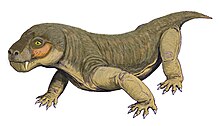Euchambersia
| Euchambersia Temporal range: Late Permian
| |
|---|---|

| |
| Euchambersia and its prey, a dicynodont | |
| Scientific classification | |
| Domain: | Eukaryota |
| Kingdom: | Animalia |
| Phylum: | Chordata |
| Clade: | Synapsida |
| Clade: | Therapsida |
| Clade: | †Therocephalia |
| Family: | †Akidnognathidae |
| Genus: | †Euchambersia Broom, 1931 |
| Type species | |
| †Euchambersia mirabilis Broom, 1931
| |
Euchambersia was a therocephalian therapsid that lived during the Late Permian epoch, approximately 250 million years ago, in what is now South Africa.
Description

Euchambersia was a unique therocephalian. It apparently had venom glands connected to its canine teeth. Like snakes, the teeth of Euchambersia were adapted to inject venom to kill its prey. A recess behind each canine tooth housed the venom gland, while grooves down the outer sides of the canine teeth delivered the venom into the puncture wound,[1] together with powerful jaws this made it a very efficient predator to hunt the herbivorous dicynodonts and pareiasaurs it encountered.[2] The discovery of another therocephalian, Ichibengops, from Zambia, Africa, may indicate that venom was more common in therocephalians than previously believed, as the specimen had grooves above its teeth not unlike those of Euchambersia.[3]
In popular culture
Euchambersia made an appearance in Walking with Monsters. Here, identified as a therocephalian, it was seen hunting Lystrosaurus in packs while the herd passed through a canyon. It is depicted as being nocturnal and having venom more potent than that of a black mamba. The model used for the Euchambersia was the same model that was used for the Thrinaxodon that appeared in the first episode of Walking with Dinosaurs.
See also
References
- ^ http://kfolinsb.public.iastate.edu/folinsbee_journal_of_verteb.pdf
- ^ "Therapsid Hunters". Archived from the original on 2007-05-19. Retrieved 2007-03-03.
- ^ http://www.sciencedaily.com/releases/2015/08/150813162339.htm



